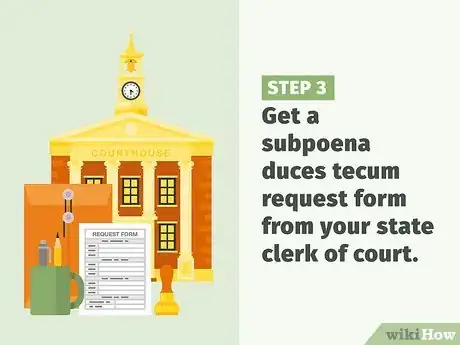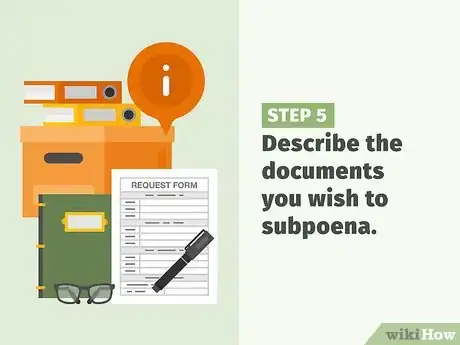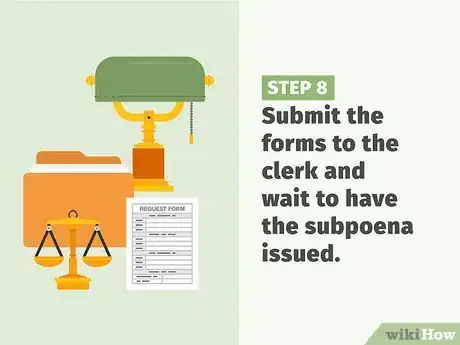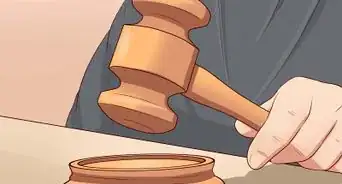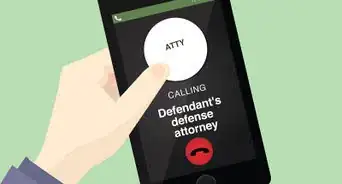This article was co-authored by Clinton M. Sandvick, JD, PhD. Clinton M. Sandvick worked as a civil litigator in California for over 7 years. He received his JD from the University of Wisconsin-Madison in 1998 and his PhD in American History from the University of Oregon in 2013.
wikiHow marks an article as reader-approved once it receives enough positive feedback. In this case, 84% of readers who voted found the article helpful, earning it our reader-approved status.
This article has been viewed 449,243 times.
If you're involved in a legal proceeding, you may need to subpoena documents to support your case. The first step is to hire an attorney to help you navigate the laws in your state and county. A subpoena duces tecum, the term for a subpoena of documents, requires that a witness produce a document relevant to your case.[1] In most cases, you will request a subpoena duces tecum from a court clerk. The court will issue the subpoena and the relevant documents must be served to the court.
Steps
Sample Documents
Acquiring and Filling Out the Subpoena Forms
-
1Work with an attorney. The laws regarding subpoenas vary from state to state and from county from county. An attorney can ensure that you take the proper legal steps to subpoena documents in your jurisdiction. Filling out the forms incorrectly or neglecting to take all the proper steps may prevent you from being able to subpoena the documents you need to make your case.
- The process you'll take to subpoena documents will differ depending on what type of suit you're involved in as well as the role of the person or company in charge of the documents. Work with an attorney to determine the best course of action to take in your individual situation.
- If you strongly prefer not to work with an attorney, be sure to conduct thorough research on your state’s subpoena laws. Go to your state's court website or visit the county clerk to find out more information.
-
2Determine who is in possession of the documents you wish to subpoena. If you know the individual who has the documents, no further research is necessary. However, you might need to subpoena documents from a company rather than an individual. If this is the case, you'll need to know the specific individual within the company will be responding to the subpoena. If you try to serve the company with a subpoena without doing this legwork first, you won't get the documents you need.[2]
- For example, if you want a record of your incoming and outgoing telephone calls from your phone company, you will want to know the name of the person in charge of the records department at that company.
- In some cases, you might be able to get the documents without going through the subpoena process if you simply request the documents you need. However, telling someone that you are involved in a suit without serving them a subpoena could give them time to destroy the documents you need so they won't be legally obligated to hand them over. Again, working with an attorney is your best bet for determining the best actions to take in your situation.
- Corporations and limited liability companies (LLC’s) have specific assigned agents for service and failing to send the document to the proper agent will result in your subpoena duces tecum being ignored. You can locate a corporation or LLC’s registered agent by visiting your Secretary of State’s website. You may also check the company’s website or call the company and ask who can accept service on behalf of the company.
Advertisement -
3Get a subpoena duces tecum request form from your state clerk of court. In most states, you'll need to fill out a request form to get the subpoena process started with the court. Some states have a separate subpoena duces tecum form, but many require you to use a standard subpoena form with an attached letter stating that you're specifically requesting documents. Visit your state or federal court website or go to the area clerk in person to get the subpoena duces tecum form and to learn about the special requirements in your state or county.[3]
-
4Complete the form. Fill in the general information. Keep in mind that the court clerk can give you minimal assistance, but he or she will not be able to give you any legal advice. This means he or she will not be able to tell you how you should describe the documents you wish to subpoena, whether or not you should issue a subpoena, or to whom you serve the subpoena. If you are unable to fill out the form with the clerk’s limited assistance, consult an attorney.
-
5Describe the documents you wish to subpoena. If the document does not have a specific name, such as "March bank statement" or "January service bill," describe it in as much detail as possible. For example, if you are asking for a copy of a letter, provide the date the letter was written, the names of the persons writing and receiving the letter, and the subject matter of the letter. Describe why the documents are necessary to prove what you're trying to prove in your case.[4]
- When subpoenaing documents, it is important not to be overly broad nor overly narrow in describing them. Otherwise, the person you are requesting the documents from may challenge the subpoena or you may be bombarded with so many documents that it will be hard for you to find the information you are looking for.
- For instance, if you only need a bank statement from only one month (i.e. "March bank statement") in a two-year period, a request for bank statements from the entire two-year period may be challenged as overly broad. By the same token, being overly narrow may prevent the document you are looking for from being turned over.
-
6Avoid subpoenaing privileged communication. Some documents that you are requesting to obtain through a subpoena duces tecum may be privileged. This means that a party can claim that are not required to disclose the document because of the type of document being requested.
- Some documents may be subject to “attorney-client privilege.” The attorney-client privilege protects communications between an attorney and his or her client by keeping those communications confidential.[5]
- The “psychotherapist-patient privilege” prevents the disclosure of confidential communication made during the course of the diagnosis or treatment of a mental or emotional condition.[6]
- The “spousal privilege” also known as the “marital” or “husband-wife” privilege, prevents the disclosure of confidential communicates made between spouses during the course of their marriage.[7]
- If you are using a subpoena duces tecum to view “privileged” communications, your request will likely be challenged in court. In addition to “privileged” documents, some types of information like trade secrets may also be challenged as inappropriate. If you are considering requesting documents that may be privileged or contain trade secrets, you should consult with an attorney.
-
7Prepare any other required documents. In many counties, non-attorneys requesting a subpoena must file a request with the court and wait for the judge to sign an order before the clerk will sign and seal a subpoena duces tecum. Check with the clerk to determine if you need to file a request with the court and to get the correct form.
-
8Submit the forms to the clerk and wait to have the subpoena issued. When you return the form to the clerk, the clerk will approve your subpoena and issue official subpoena forms. Make sure you have a copy to keep for yourself and one to serve to the party in charge of the documents you're requesting.
Serving the Subpoena
-
1Have the subpoena served. Your state’s laws will determine the acceptable manner of service of a subpoena duces tecum. Check with the court clerk, a local attorney, or your state’s Civil Rules of Procedure for state-specific rules and regulations. Not all methods of delivery are acceptable in every state; check with your clerk of court for your area's specific requirements. Common methods of service include the following:
- Personal service. Personal service means the hand delivery of the document by someone other than yourself. In the case of a subpoena duces tecum, this is a preferred method of service.[8] All states require that the person delivering the document(s) is at least eighteen years old. Many also require that the party delivering the document(s) sign and file with the court an affidavit of service, which describes how he or she delivered the document.
- First class United States mail. Most mail you send and receive is likely sent this way. While serving many types of court documents via first class mail is acceptable, it may not be in the case of a subpoena duces tecum in your state.
- Certified mail. Certified mail, whether a return receipt is requested or not, is almost always an acceptable form of service for court orders such as a subpoena duces tecum.
-
Facsimile or other delivery method. Under certain circumstances, you may be able to deliver your subpoena in an informal manner, such as by fax or email attachment.
- For example, this may be acceptable when a party has already agreed to provide you with the documents, but you must provide a subpoena duces tecum for legal purposes due to her company’s policy requirement.
-
2Ensure that a proof of service form is completed. This form should be filled out by the person who served the subpoena. It describes the form of service and confirms that the subpoena was received.
-
3Submit the completed forms to the court clerk. The court needs the forms to verify that the subpoena was served. It is now up to the person who was served to send the requested documents to the court clerk by the date specified in the subpoena.
-
4Review the documents. You likely want to view the documents before your case proceeds. Viewing them ahead of time will help you familiarize yourself with the facts of your case and ensure that you actually want to submit the document(s) as evidence. [9] The specifics for gaining access to your documents may vary from state to state, but the general process is as follows:
- For a criminal case subpoena, the documents will be delivered directly to the clerk of court or judge. The court will determine what kind of access you will have to the documents.
- For a civil case subpoena, the subpoena will specify whether you are asking to view the documents or you are requesting copies delivered to you.
- If you are simply requesting access to the documents, the recipient of the subpoena can specify where and when (typically normal business hours) you can either view or copy documents yourself.
- If you request copies, they will be mailed or delivered to you by the recipient. The records will be accompanied with an affidavit or declaration about the documents and how they were prepared. The recipient of the subpoena is entitled to costs for responding to the subpoena, including copying costs and payment for the hours it took employees to prepare the documents.
Warnings
- The subpoena duces tecum process can take quite a bit of time, even when everything goes smoothly. You should allow approximately fourteen to thirty days for the entire process.⧼thumbs_response⧽
- This article is intended for general information purposes only, and is not meant to fully describe the procedure for every county and state. Please check with your local county clerk’s office or a licensed attorney for information specific to your county and state.⧼thumbs_response⧽
- This article is for informational purposes only and not for the purpose of providing legal advice. You should contact an attorney to obtain advice with respect to your particular issue or problem. If you need additional guidance you may contact a lawyer through your State Bar Association. State and County bar associations often have free referral services to qualified local attorneys and may offer free consultations with attorneys that specialize in handling the legal issues relevant to your case.⧼thumbs_response⧽
References
- ↑ https://www.law.cornell.edu/wex/subpoena_duces_tecum
- ↑ http://www.nolo.com/legal-encyclopedia/free-books/small-claims-book/chapter14-5.html
- ↑ http://www.nolo.com/legal-encyclopedia/free-books/small-claims-book/chapter14-5.html
- ↑ http://www.nolo.com/legal-encyclopedia/free-books/small-claims-book/chapter14-5.html
- ↑ Swidler & Berlin v. United States, 524 U. S. 399, 403 (1998)
- ↑ Jaffee v. Redmond, 518 U.S. 1 (1996)
- ↑ Trammel v. United States, 445 U.S. 40 (1980)
- ↑ http://www.washingtonlawhelp.org/resource/how-to-subpoena-witnesses-and-documents
- ↑ http://www.nolo.com/legal-encyclopedia/free-books/small-claims-book/chapter14-5.html
About This Article
To subpoena documents, obtain a subpoena duces tecum request form from your state clerk of court in person or download it from the court's website. Fill in the general information on the form, then describe the documents you wish to subpoena and why they're necessary for your case. Then, submit the form to the clerk and wait for the clerk to approve your subpoena and issue the official subpoena forms. For more information about serving subpoenas, read on!





